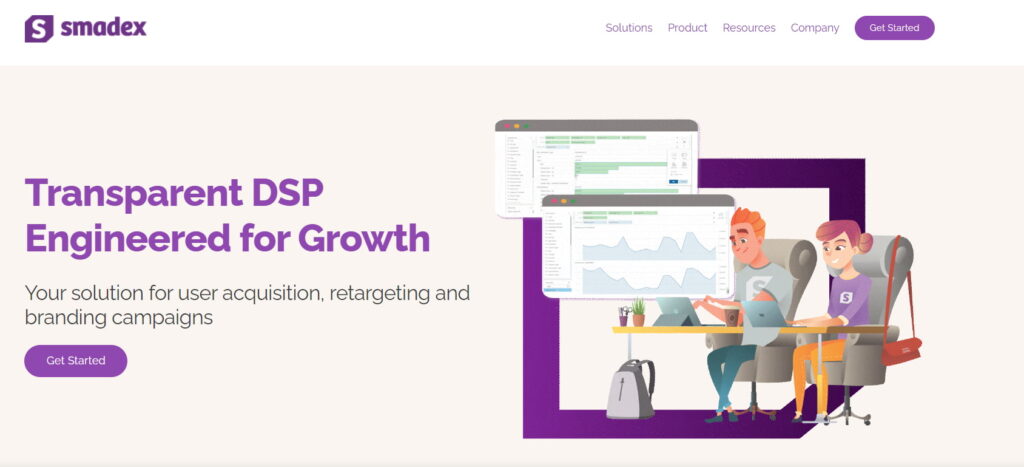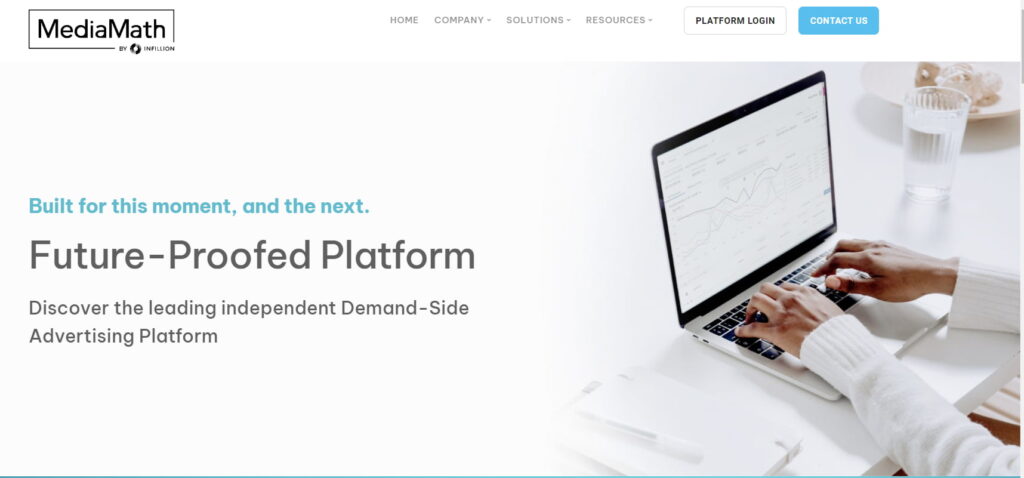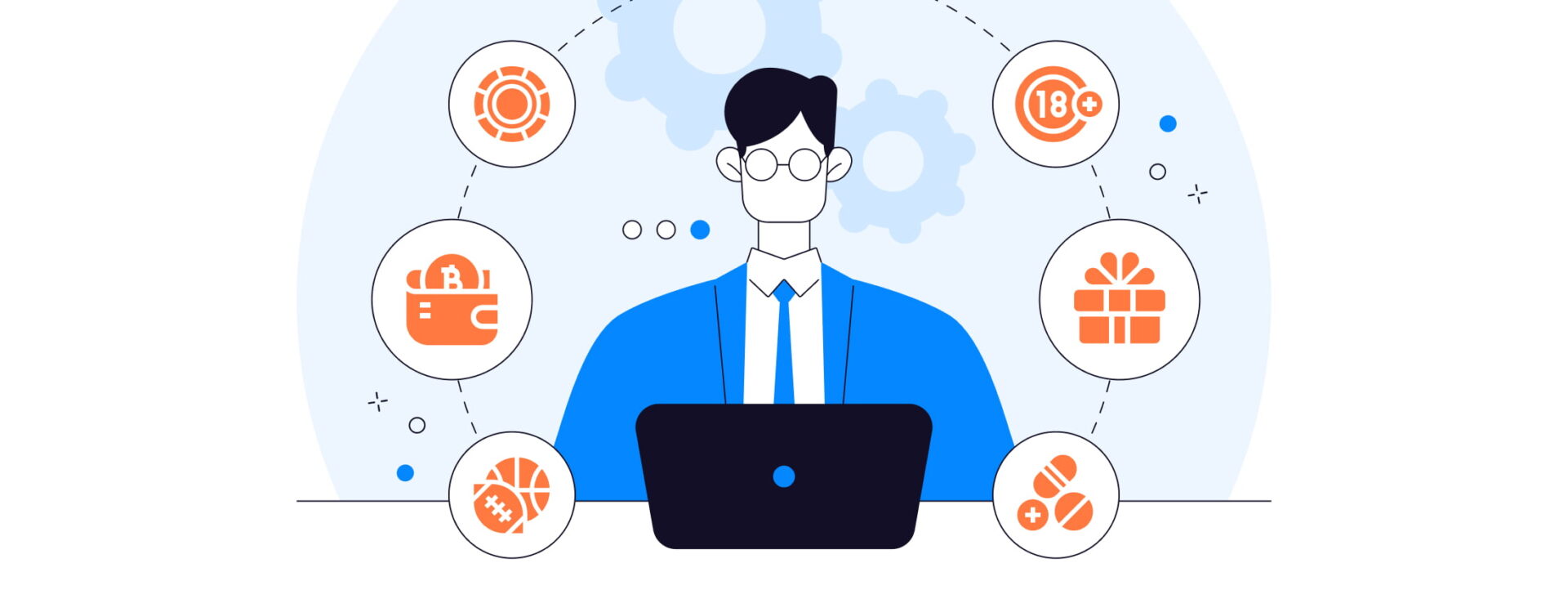Blog

In 2024, programmatic advertising shows no signs of slowing down due to its rapid nature and simplicity of processes, as it allows advertisers to manage several ads across multiple ad networks within one interface.
Yet, not all the affiliates and advertisers realize what is a DSP platform, how it actually works and where to find the examples.
The article explains the notion of DSP platform, as well as provides examples of the top 6 demand side platforms.
A demand-side platform (DSP) is a digital advertising tool that empowers advertisers to purchase ad space across various online platforms efficiently, it’s a bridge between advertisers and sell-side platforms (SSPs). Think of it as a high-tech marketplace where brands can bid for their ads to appear in front of specific audiences, all in real-time.
Typically, DSP platforms use Real-Time Bidding (RTB) auctions, which streamline and accelerate the buying and selling of ad space for both websites and advertisers.
Benefits of using a DSP:
There are several key actors that participate in DSP functioning, including advertiser, ad exchange, SSP, and publishers.

Step-by-step functionality of demand side platform advertising:
The advertiser logs into the DSP platform to set up their campaign. They input their targeting criteria, budget, and other parameters. The DSP provides tools for audience segmentation and performance tracking.
Using algorithms and data analytics, the DSP analyzes vast amounts of data to identify potential audiences across multiple ad exchanges. It assesses user behavior, demographics, and contextual signals.
The DSP connects to an ad exchange, which serves as a marketplace where advertisers can bid on available ad inventory from various publishers.
When a user visits a website (publisher’s site), the ad exchange sends out a request for ads in real-time. This request includes user data and available inventory.
The SSP receives the request from the ad exchange and identifies available ad spaces from its connected publishers. It also collects bids from various DSPs for that inventory.
The DSP evaluates the bidding opportunity based on the advertiser’s set parameters and audience targeting. It places a bid in real-time for the available ad space through the ad exchange.
The ad exchange compares all incoming bids from different DSPs and selects the highest bid. This winning bid is then matched with the corresponding ad creative from the advertiser.
The winning ad is displayed to the user on the publisher’s website. The publisher earns revenue based on the impressions or clicks generated by the ad.
After the ad is displayed, the DSP tracks its performance using various metrics (e.g., impressions, clicks, conversions). This data helps optimize future campaigns by adjusting targeting strategies for reallocating budgets.
Finally, the DSP compiles detailed reports for the advertiser, providing insights into campaign performance and areas for improvement. The advertiser can then change their strategy for future campaigns based on this data.
There are several best DSP platforms on the market that are worth highlighting, we’ve collected the main below.

Google Marketing Platform combines various tools for marketers, providing a comprehensive suite for digital advertising. It integrates Google Ads and Display & Video 360, allowing advertisers to manage their campaigns across multiple channels.
What’s more, it offers advanced machine learning algorithms for automated bidding and optimization, as well as creative management tools.

Knorex is an integrated marketing platform that offers programmatic advertising solutions across various channels, including display, mobile, and social media. It focuses on helping brands optimize their ad spend with real-time data analysis.
The platform uses first-party data and AI-driven insights to enhance targeting and campaign performance.

RichAds is a programmatic advertising platform that specializes in push and pop ads. The platform supports various ad formats, including in-page and classic push ads,pops, direct click, native and telegram ads, ensuring versatility in advertising with 5+ billion daily impressions.
It provides access to a global market offering traffic from 220 GEOs and focuses on maximizing ROI for advertisers through targeted campaigns. The network offers detailed analytics on user engagement and campaign performance, combined with AI optimization tools, like Target CPA, Performance Mode, Automated Rules to automate the advertising process.

Smadex is a programmatic advertising platform designed for mobile app marketers. It offers real-time bidding and optimization to help brands reach their target audiences effectively, offering 3 billion mobile devices, 4000+ CTV channels, and 2.5 downloads a month.
The platform emphasizes programmatic direct deals with premium publishers to ensure quality traffic.

MediaMath is a leading independent DSP that provides marketers with a robust platform for managing digital advertising campaigns across multiple channels. It emphasizes data-driven decision-making.
One more distinctive feature is that it integrates first-party and third-party data sources for comprehensive audience insights. What’s more, the platform calls itself the sole DSP that shares predicted action rate data with external SSP partners, delivering CPAs that are 40% more effective.

Amazon omnichannel DSP allows advertisers to programmatically buy display and video ads both on Amazon’s platforms and across the web. It leverages Amazon’s rich shopper data for precise targeting.
It uses Amazon’s vast customer data, including purchase history and browsing behavior as well as offers unique access to Amazon’s retail inventory and exclusive ad placements on Amazon properties.
DSP advertising is more than lucrative for affiliates, allowing them to use multiple channels across just one platform in real-time and at affordable pricing. As advertisers seek data-driven solutions, DSPs have emerged as essential tools for navigating the complexities of digital media.
In conclusion, as programmatic advertising continues to grow, DSPs will be at the forefront of this transformation, driving efficiency and effectiveness. Embracing these platforms is not just an option but a necessity for those looking to thrive and increase profits in a data-driven world.
In 2024, programmatic advertising shows no signs of slowing down due to its rapid nature and simplicity of processes, as it allows advertisers to manage several ads across multiple ad networks within one interface.
Yet, not all the affiliates and advertisers realize what is a DSP platform, how it actually works and where to find the examples.
The article explains the notion of DSP platform, as well as provides examples of the top 6 demand side platforms.
A demand-side platform (DSP) is a digital advertising tool that empowers advertisers to purchase ad space across various online platforms efficiently, it’s a bridge between advertisers and sell-side platforms (SSPs). Think of it as a high-tech marketplace where brands can bid for their ads to appear in front of specific audiences, all in real-time.
Typically, DSP platforms use Real-Time Bidding (RTB) auctions, which streamline and accelerate the buying and selling of ad space for both websites and advertisers.
Benefits of using a DSP:
There are several key actors that participate in DSP functioning, including advertiser, ad exchange, SSP, and publishers.

Step-by-step functionality of demand side platform advertising:
The advertiser logs into the DSP platform to set up their campaign. They input their targeting criteria, budget, and other parameters. The DSP provides tools for audience segmentation and performance tracking.
Using algorithms and data analytics, the DSP analyzes vast amounts of data to identify potential audiences across multiple ad exchanges. It assesses user behavior, demographics, and contextual signals.
The DSP connects to an ad exchange, which serves as a marketplace where advertisers can bid on available ad inventory from various publishers.
When a user visits a website (publisher’s site), the ad exchange sends out a request for ads in real-time. This request includes user data and available inventory.
The SSP receives the request from the ad exchange and identifies available ad spaces from its connected publishers. It also collects bids from various DSPs for that inventory.
The DSP evaluates the bidding opportunity based on the advertiser’s set parameters and audience targeting. It places a bid in real-time for the available ad space through the ad exchange.
The ad exchange compares all incoming bids from different DSPs and selects the highest bid. This winning bid is then matched with the corresponding ad creative from the advertiser.
The winning ad is displayed to the user on the publisher’s website. The publisher earns revenue based on the impressions or clicks generated by the ad.
After the ad is displayed, the DSP tracks its performance using various metrics (e.g., impressions, clicks, conversions). This data helps optimize future campaigns by adjusting targeting strategies for reallocating budgets.
Finally, the DSP compiles detailed reports for the advertiser, providing insights into campaign performance and areas for improvement. The advertiser can then change their strategy for future campaigns based on this data.
There are several best DSP platforms on the market that are worth highlighting, we’ve collected the main below.

Google Marketing Platform combines various tools for marketers, providing a comprehensive suite for digital advertising. It integrates Google Ads and Display & Video 360, allowing advertisers to manage their campaigns across multiple channels.
What’s more, it offers advanced machine learning algorithms for automated bidding and optimization, as well as creative management tools.

Knorex is an integrated marketing platform that offers programmatic advertising solutions across various channels, including display, mobile, and social media. It focuses on helping brands optimize their ad spend with real-time data analysis.
The platform uses first-party data and AI-driven insights to enhance targeting and campaign performance.

RichAds is a programmatic advertising platform that specializes in push and pop ads. The platform supports various ad formats, including in-page and classic push ads,pops, direct click, native and telegram ads, ensuring versatility in advertising with 5+ billion daily impressions.
It provides access to a global market offering traffic from 220 GEOs and focuses on maximizing ROI for advertisers through targeted campaigns. The network offers detailed analytics on user engagement and campaign performance, combined with AI optimization tools, like Target CPA, Performance Mode, Automated Rules to automate the advertising process.

Smadex is a programmatic advertising platform designed for mobile app marketers. It offers real-time bidding and optimization to help brands reach their target audiences effectively, offering 3 billion mobile devices, 4000+ CTV channels, and 2.5 downloads a month.
The platform emphasizes programmatic direct deals with premium publishers to ensure quality traffic.

MediaMath is a leading independent DSP that provides marketers with a robust platform for managing digital advertising campaigns across multiple channels. It emphasizes data-driven decision-making.
One more distinctive feature is that it integrates first-party and third-party data sources for comprehensive audience insights. What’s more, the platform calls itself the sole DSP that shares predicted action rate data with external SSP partners, delivering CPAs that are 40% more effective.

Amazon omnichannel DSP allows advertisers to programmatically buy display and video ads both on Amazon’s platforms and across the web. It leverages Amazon’s rich shopper data for precise targeting.
It uses Amazon’s vast customer data, including purchase history and browsing behavior as well as offers unique access to Amazon’s retail inventory and exclusive ad placements on Amazon properties.
DSP advertising is more than lucrative for affiliates, allowing them to use multiple channels across just one platform in real-time and at affordable pricing. As advertisers seek data-driven solutions, DSPs have emerged as essential tools for navigating the complexities of digital media.
In conclusion, as programmatic advertising continues to grow, DSPs will be at the forefront of this transformation, driving efficiency and effectiveness. Embracing these platforms is not just an option but a necessity for those looking to thrive and increase profits in a data-driven world.

Blog

Blog